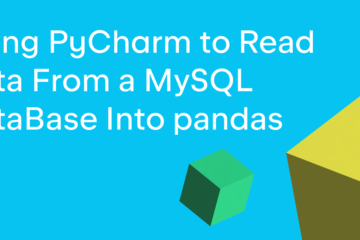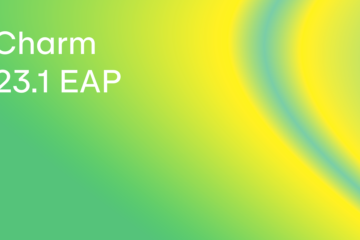This week we welcome Will McGugan (@willmcgugan) as our PyDev of the Week! Will is the author of the Rich package, which is for for rich text and beautiful formatting in the terminal. If you have a moment, you should check out Will’s blog. Will is also the author of Beginning Game Development with Python and Pygame. You can see what other projects he contributes to over on GitHub.
Let’s spend some time getting to know Will better!
Can you tell us a little about yourself (hobbies, education, etc):
I grew up in a small town in North East Scotland. My career took me around the UK, including some years in Oxford and London. I’ve since returned to Scotland where I live in Edinburgh with my wife. I’m quite fortunate to have been working from home as a freelance software developer long before the pandemic started.
I’m mostly self taught, having dropped out of University to work in video games. Although I think by the time you reach my age all developers are self-taught. In such a fast-moving industry learning on the job is a must.
My main hobby outside software development is photography—in particular, wildlife photography. I once spent a night in a Finnish forest shooting wild Eurasian bears. That was quite an experience! As soon as the world returns to normal I plan to do way more traveling and photography.
I post many of my photographs on my blog and if you prompt me I’ll talk at length about focal lengths and bokeh.
Why did you start using Python?
I discovered Python back in the early 2000s when I worked in video games. I was looking for a scripting language I could compile in to a game engine to manage the game mechanics while C++ handled the heaving lifting and graphics. I considered Python, Ruby, and Lua. After some research and experimentation I settled on not Python, but Lua.
Lua was probably the best choice for that task but I found myself turning to Python for scripts and tools. I viewed Python then as more of an upgrade to Windows batch files and not as a real programming language. Only when the scripts I was writing grew more sophisticated did I begin to appreciate the expressiveness of Python and the batteries included approach. It was a refreshing change from C++ where so much had to be written from scratch.
Fast forward a few years and I made the switch to working with Python full-time, writing a chess interface for the Internet Chess Club. Python has been the focus of my career ever since, and even though I spent years learning C++, I don’t regret the switch!
What other programming languages do you know and which is your favorite?
The main other languages I use day-to-day is Javascript and Typescript (if that counts as another language), often in the context of a web application with a back-end written in Python.
It’s been a while but did a lot of work with C and C++ back in the day. I also wrote a fair amount of 80×86 assembly language, at a time where hand-tuning instructions was a sane thing to do.
My favorite language is of course Python. I love the language itself and the ecosystem that has grown around it.
What projects are you working on now?
My side project is currently Rich, a library for fancy terminal rendering. I’ll talk more about that later.
My day job has me building technology for dataplicity.com, which is a remote administration tool targeted at the Raspberry Pi single-board computer (but works with any Linux). Other than the front-end, the stack is entirely running on Python.
Which Python libraries are your favorite (core or 3rd party)?
I’m a huge fan of asyncio as a lot of work I do requires concurrency of some sort or another. I’ve used Twisted and Tornado to do very similar things in the past, but asyncio with the async and await keywords have made for a much more pleasant experience. Related, is aiohttp a web framework on top of aiohttp which I’ve used in the day job to build a highly-scalable websocket server.
Two libraries I like right now are PyDantic and Typer. I really like the way they use typing to create objects that can be statically checked with Mypy and related tools. The authors are pioneers and I hope to see more of this approach in the future!
How did the Rich package come about?
Some time ago my side-project was a web application framework called Moya. While building the command line interface for Moya I put together a “Console” class which turned out to be the prototypal version of Rich. The Moya Console class was not terribly well thought out and hard to separate from the main project, but there were some really good ideas there and I always thought I should build a standalone version of it.
I would revisit this idea in my mind every time I struggled to read some ugly badly formatted terminal output (often implemented by myself). I wished that this Uber-console I was formulating in my head already existed fully-fledged and documented, but it wasn’t going to write itself. Sometime in late 2019, I started work on it.
The core features came together quite quickly. Incidentally, I was in Wuhan, China just a few weeks before the pandemic hit when the first rich output was generated (naturally a bold magenta underlined blinking “Hello, World!”).
The first core feature was rich text, which is where the package name was derived. I could associate styles with a range of characters in a string, much like the way you can markup text in HTML. And that marked-up string could then be further manipulated while preserving the styles. That one feature made so many others possible, like syntax highlighting and markdown rendering.
The v1.0.0 release came out in May 2020 and it really took off, way more than I was expecting. There were bugs of course and plenty of feedback. I had intended to leave it there and maybe just maintain it for a while, but there were so many good suggestions for features that I kept working on it. At the moment I’m considering more TUI (Text User Interface) features to make terminal-based applications.
What are Rich’s strengths and weaknesses?
The main strength is probably the composability of the renderables (renderable is my term for anything that generates output in the terminal). For instance, a table cell may contain a panel (or any other renderable) that may itself contain another table, carrying on ad-infinitum, or at least until you run out of characters. It’s a model that allows you to quickly create elegant formatting in the terminal more like a web page than a stream of characters. One user even wrote his CV (résumé) using Rich, and it looks great!
One weakness may be the emoji support. Everyone loves emoji in terminal output. But what many don’t realize is that terminal support for emojis is spotty. Not all terminals display emojis with the same width, so the very same output may look neat on one terminal but have broken alignment on another and, to make matters worse, there is no way for Rich to detect how emoji are rendered.
Is there anything else you’d like to say?
I post Python-related articles on my blog (https://www.willmcgugan.com) from time to time. I’m @willmcgugan on twitter.
Thanks for doing the interview, Will!
The post PyDev of the Week: Will McGugan appeared first on Mouse Vs Python.


